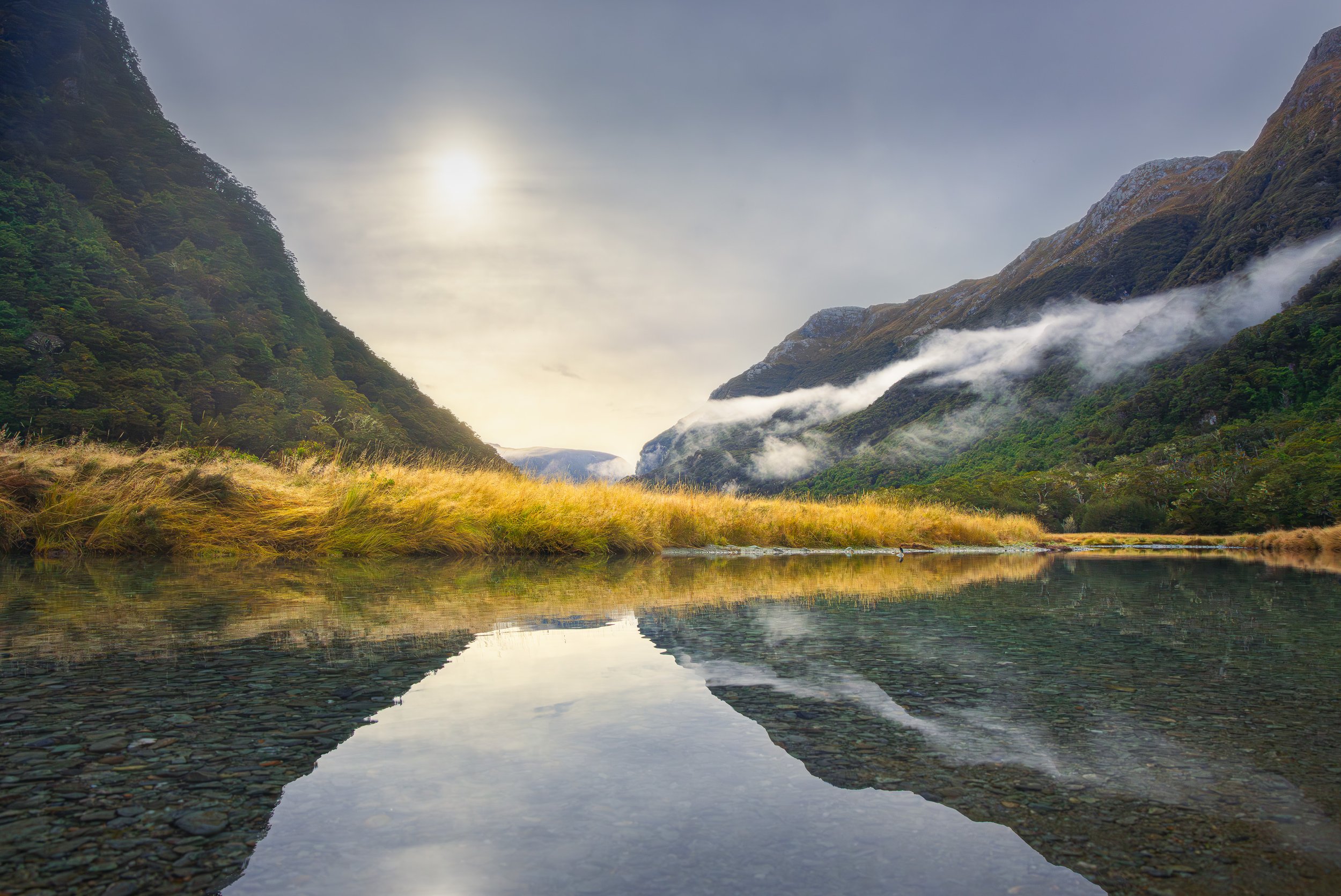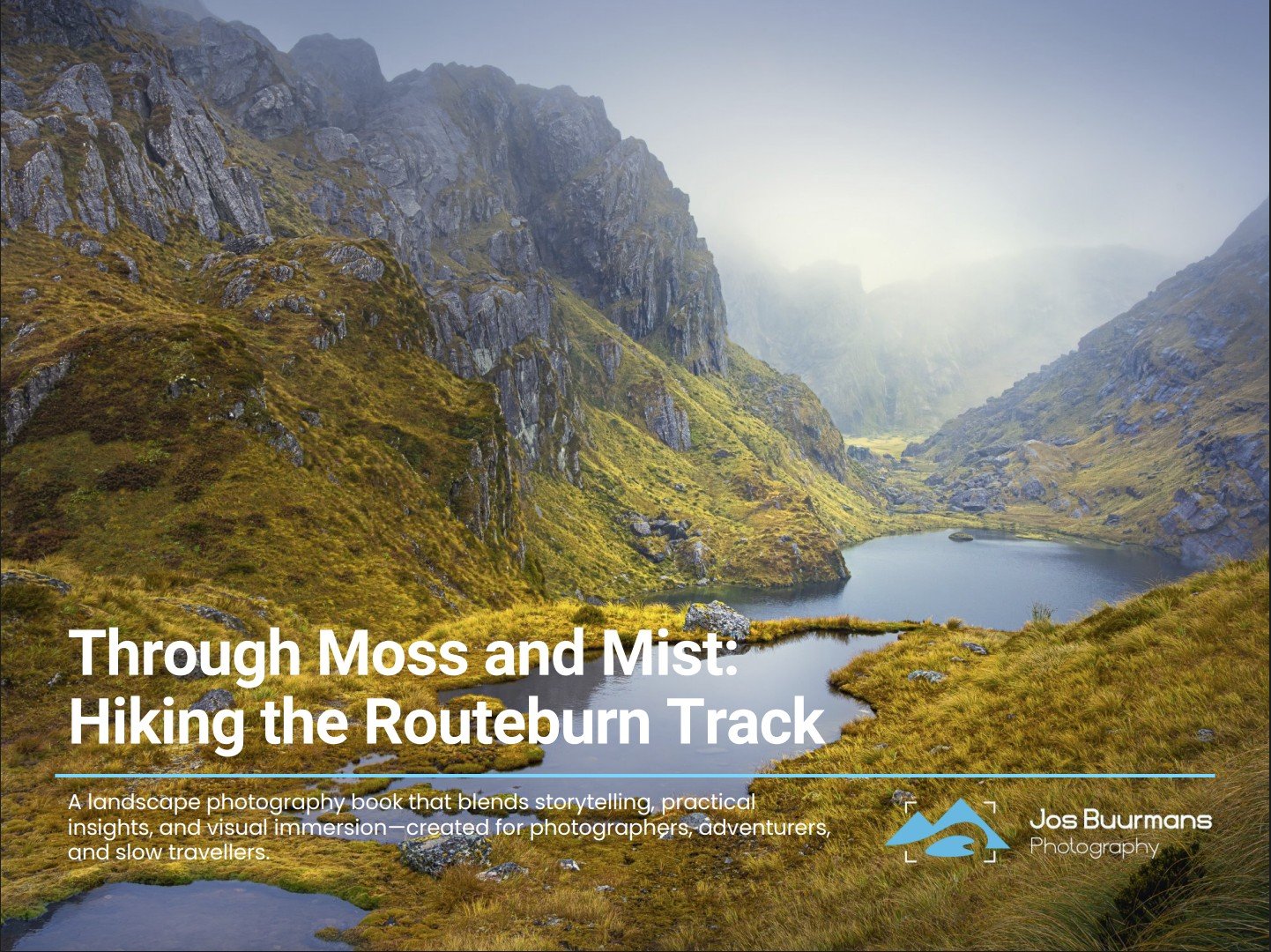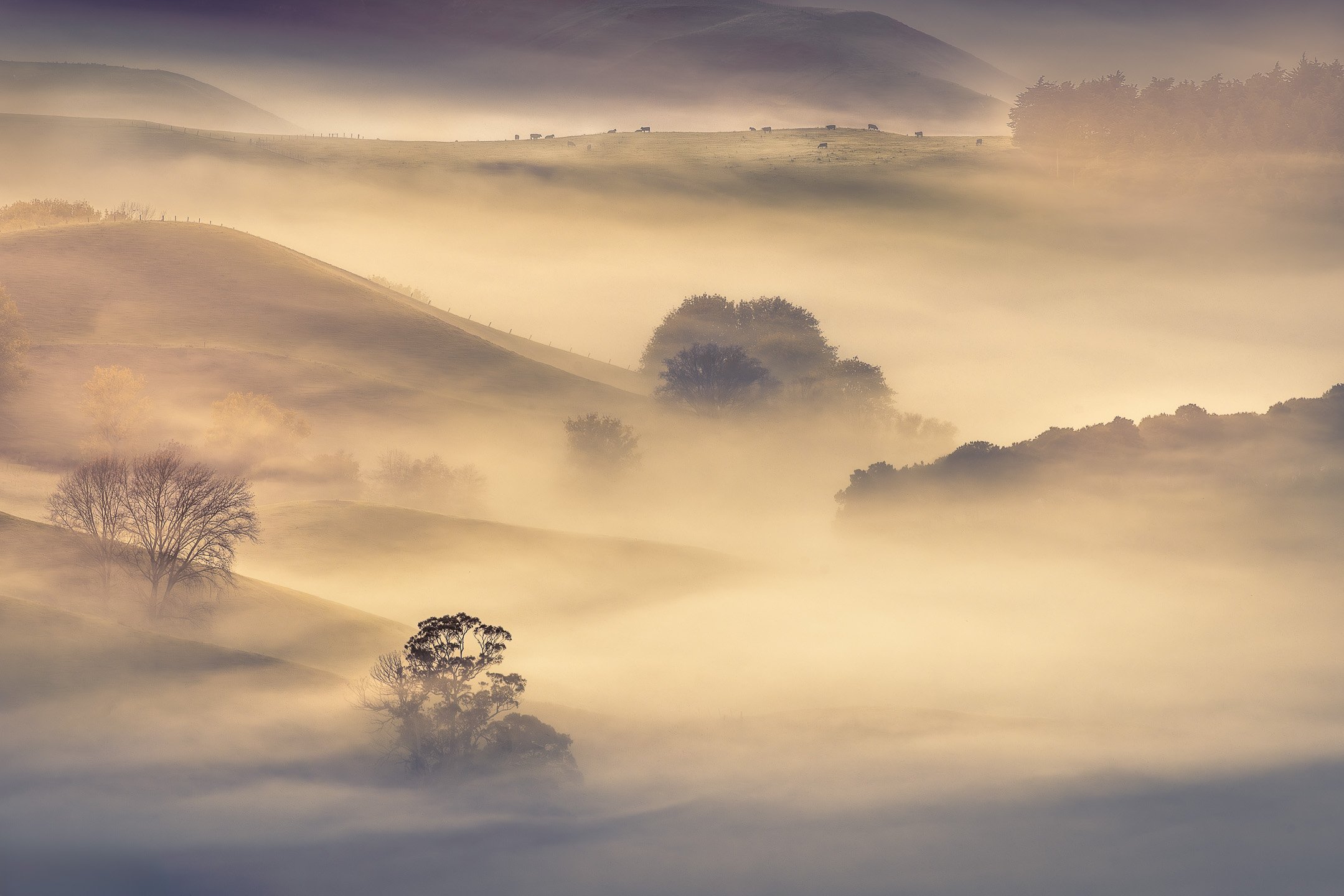Through Moss and Mist: Hiking the Routeburn Track
A visual and sensory story about a three-day journey of one of New Zealand’s most scenic Great Walks.
We’re walking one of New Zealand’s Great Walks—the Routeburn Track—33 kilometers of alpine wilderness stretching through Fiordland and Mount Aspiring National Parks. Along the way: moss-covered beech forests, turquoise rivers, sweeping meadows, and vast mountain vistas.
We begin at The Divide, near Milford Sound, in late March 2025. The first morning is bright—sun and blue sky with scattered clouds. Over the next three days, the weather shifts: light rain, low cloud, and mist become our companions. Far from being a drawback, the changing conditions deepen the experience, adding mood and mystery to New Zealand’s Southern Alps.
Day One: Mossy Greens and Alpine Views
The walk begins at The Divide, a mountain pass where waters flow in two directions—west to the Tasman Sea, and east to the Pacific. The track here is well-formed and gently climbs through lush temperate rainforest typical of Fiordland.
Almost immediately, we’re immersed in silver beech forest. The trees are tall and slender, their trunks and branches thick with moss. It’s not just on the trees—moss sprawls over rocks and blankets the ground like a breathing carpet. Ferns unfurl bright green fronds under a dense canopy, while lichens and liverworts add silvery hues to the forest palette. Occasionally, the sounds of flowing water or birds such as tūī and bellbirds interrupt the silence.
Moss-Covered Tree
The trunk and branches of a tree along the Routeburn Track that are covered in moss.
Small Forest Waterfall
There are plenty of waterfalls along the Routeburn Track. This unnamed one is found right at the beginning of the track within the lush vegetation of Fiordland's temperate rainforest.
Routeburn Greens
The sun coming through moss-covered trees and ferns on the Routeburn Track.
Sunlight breaks through the canopy in rare moments, sending beams of light into the green gloom. These shafts illuminate textures and shapes, revealing details that spark the imagination and give the forest an almost otherworldly glow.
Hiking into the Beam
A beam of sunlight lights up the path for two people hiking the Routeburn Track.
Moss Ball
A group of silver beech trees, their trunks and branches thickly draped in moss, seem to curve inward, forming a tunnel of green that draws the eye to a single delicate branch at the centre—its tip crowned with a ball of moss.
As we climb, the forest thins and the views open. A short detour to Key Summit offers expansive panoramas of the Humboldt and Darran Mountains. The weather remains changeable—clouds sweep across the sky, casting moving shadows on the ridges.
Mountain through Beech Trees
Walking just below the tree line provides a glimpse of one of the many peaks along the way.
Rainbow at Earland Falls
A close-up of the rainbow at Earland Falls.
Key Summit
Fast-moving clouds race across a predominantly blue sky, demanding quick reflexes with the camera as the mountains draw the clouds like magnets.
Earland Falls
Looking up at a sheer, 174-meters high wall where the water of Earland Falls fans out and catches the light.
We descend through a section called The Orchard and arrive at Mackenzie Lodge, where a hot shower and a warm meal wait.
Small Orchard Tarn
An enclosed tarn close to The Orchard.
Day Two: Shrouded in Mist
We begin with a steady climb to Harris Saddle, the highest point on the track at 1,255 meters. Today, we’re wearing rain jackets, and the landscape is cloaked in mist—no sweeping views, just soft light and silence. So we look closer. Waterfalls emerge through the fog. Alpine plants—compact, resilient—reveal a quiet beauty.
Mountain Daisy Rosette
The structured elegance of a mountain daisy rosette, its broad lance-shaped leaves radiating outward in precise, layered symmetry.
Pineapple Scrub Rosettes
Pineapple scrub rosettes bursting with colour and symmetry—vivid green centres fading to red, each leaf tipped with glistening raindrops.
At the saddle, we stop for lunch at the shelter. Slowly, the mist begins to lift, revealing glimpses of Lake Harris and distant ranges. The shifting weather creates fleeting, moody scenes—perfect for anyone drawn to soft light and atmosphere.
Tarns to Lake Harris
The Routeburn Track near the Harris Saddle looks out over several tarns before reaching the larger Lake Harris. In the background, the Valley of Trolls is shrouded in mist.
From the saddle, the trail descends along a rocky path bordered by mosses, flax, hebes, and golden tussock. The Routeburn Left Branch comes into view, winding through a wide alpine basin. Yellow grass glows beneath dark slopes, mist drifts low, and the sense of isolation is powerful.
Journey into the Wild
A winding alpine trail leads the eye—and the spirit—into the heart of New Zealand’s Southern Alps. Captured near the descent from Harris Saddle along the Routeburn Track, this moody landscape reveals the Routeburn Left Branch in all its raw splendour. Mist clings to the peaks, golden tussock glows in the valley below, and the sense of solitude is as vast as the land itself.
Once in the valley, we follow the winding river. At times we walk close enough to hear meltwater rushing over rocks; at other times the river moves quietly through the golden grasses. We pass several small waterfalls, tucked among old rocks and moss. We end the day at Routeburn Falls Hut.
Cascade in the Alpine Basin
A slender waterfall spills through sculpted schist and moss-covered rock, capturing the quiet energy of the Routeburn Left Branch basin. Surrounded by golden tussock and mist-draped peaks, this hidden cascade offers a moment of intimacy within the vast alpine landscape.
Day Three: Clearing Mist and Turquoise Rivers
On day three, the sun makes a brief attempt to pierce the cloud cover. At sunrise, it breaks through for a moment, casting bright light across the landscape—before mist and clouds return, softening everything into a diffuse glow. The mist feels like a natural part of this place, adding atmosphere and mystery. For photography, it transforms the scene, lending depth, mood, and a sense of quiet drama.
After a short forest walk, we reach a clearing with a view of the Routeburn River winding through the valley. The mist is lifting now, leaving thin strands trailing across golden grass and calm water.
Mist over the Routeburn River
A thin veil of mist lingers over the Routeburn River that flows through the valley covered in golden grass.
Bands of Low Cloud
Low bands of cloud drift and linger over the Routeburn Valley, suspended between forested slopes as the morning sun slowly rises and warms the landscape.
Tree above the Mist
A bare tree stands like a skeleton, overlooking the green forest and a mist-covered valley below.
We arrive at the Routeburn Flats—a wide alpine meadow where the river braids and slows. It’s a place that invites pause. We walk through the tussock to the water’s edge, reflections of forested slopes and distant peaks shimmering on the surface. A tomtit briefly lands on a rock, then disappears before the camera is ready.
Routeburn Flats
Ferns in the foreground draw the eye toward the golden grasses of the wide, open meadow known as the Routeburn Flats.
Routeburn Flats Reflection
At the Routeburn Flats, the river slows and spreads, reflecting the steep forested slopes and distant peaks in its still surface.
Further along the river, we find a perfect spot for lunch. The water here is a vivid turquoise. We linger.
Turquoise Routeburn River
A gorgeous place to have lunch along the river.
Veins of Stone and Water
Three streams converge in a hidden gorge along the Routeburn Track, carving through ancient rock and spilling into a turquoise basin below. A moment of stillness in the midst of constant motion.
The final stretch winds through mossy forest with occasional, breath-taking views of river cascades until we reach the Routeburn Shelter. On the way, we’re treated to one last surprise—a South Island robin hops into view and inspects our boots with absurd diligence.
Boot Inspection
A South Island robin inspects our boots at the exit of the Routeburn Track.
South Island robin (Kakaruai)
The South Island robin is a sparrow-sized bird found only in New Zealand, where it has the status of a protected endemic species.
Tips for Photographers
Multi-day hikes often present a dilemma for landscape and nature photographers: do you travel light and risk leaving behind gear you might need, or carry most of your equipment and accept the extra weight and effort that comes with it?
For this trip, I chose to bring two lenses: my standard zoom (24–105mm) and a telephoto (100–500mm). The tele lens seemed like a good idea—for birds, and for capturing distant mountain details, like I did when walking the Milford Track a few years ago. I left my ultra-wide-angle lens behind, limiting my widest focal length to 24mm. In hindsight, I used the telephoto only a couple of times, mainly for a few close-ups of Earland Falls. For most of the journey, it stayed in the bag.
Next time, I think I’d swap the telephoto for the ultra-wide. The Routeburn Track passes through beautifully detailed vegetation, mossy forest scenes, and layered terrain that would have benefited from the added depth and field of view a wider lens provides.
I also chose to go without a tripod. Thanks to modern in-body image stabilisation (IBIS), it’s easier than ever to capture sharp handheld images, which helps when you're shooting on the move. And with today's noise reduction tools, bumping up the ISO isn’t the issue it once was. Most of my forest shots were taken at ISO 800 and cleaned up effortlessly with Lightroom Denoise. The slowest shutter speed I used was 1/6 of a second to capture the movement of waterfalls. In most cases, I blended these slower exposures with sharper images taken at faster shutter speeds during post-processing. This approach allowed me to retain motion blur in the water while preserving detail and clarity in the surrounding landscape.
I carried an Atlas Athlete Camera Backpack to hold my camera gear, clothing, and food, but on this trip, I also experimented with using a Lowepro front pack for my camera with the standard zoom lens attached. The idea was to keep the camera easily accessible while protecting it from the elements—so I wouldn't have to stop and remove my backpack every time I wanted to take a shot. And it would give me more room in my backpack for additional clothing and food. Overall, it worked well. The only drawback was that the front pack obscured my view of the ground directly beneath me, which occasionally made it harder to judge footing and affected my balance on uneven terrain. I will use this combination of packs again.
Mist and overcast sky in combination with dark forest required exposure bracketing to ensure I captured the full tonal range of the scene without overexposing the highlights and underexposing the shadows that I blended during post-processing. See my articles about exposure bracketing and exposure blending.
There are several waterfalls along the Routeburn Track that are well worth photographing. And if you're like me, you probably prefer the look of silky, flowing water over the "frozen" effect created by fast shutter speeds. To achieve that dreamy motion blur, you'll need a slow shutter speed—which can be tricky without a tripod.
So, how can you do it? I have documented the technique to get a sharp landscape with beautifully flowing water in the ebooklet below.
Inspired by the journey?
Take the experience further with my ebook — a curated blend of stories, insights, and stunning visuals. Or bring the Routeburn Track home with a fine art print from the collection.
Download the eBook
The above visual story is available for purchase as an ebook, containing over 40 pages of images and information.
A visual journey and photography guide for travellers, hikers, and photographers drawn to the wild beauty of New Zealand’s Routeburn Track. Blending evocative imagery with personal insights, this book captures the mood, detail, and atmosphere of one of Aotearoa’s most iconic Great Walks.
Table of Contents:
Visual story with over 20 pages of annotated images
14 pages with tips for photographers, including:
What gear to bring
Techniques for taking photos along the Routeburn Track
In Depth: How to create a long exposure without a tripod
Image Index with location and technical details of each image
Purchase a fine art print
All these images are for sale as a print or canvas on my store.
Share this article
If you would like more of these visual stories, then scroll to the bottom and subscribe to my newsletter.






































A visual story of a photography trip to Cape Farewell including a sunrise and sunset at Wharariki Beach, a hike on top of the cliffs, and an exploration of Farewell Spit.